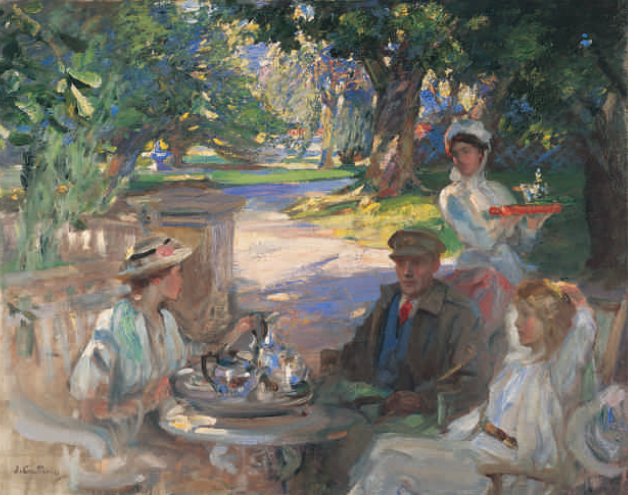
The Garden Party. Sir James Guthrie HRA PRSA HRSW HROI (1859–1940). Oil on canvas, 30 x 38 inches; 76.2 x 96.5 cm. Signed and inscribed label verso. Provenance: Sir F.C. Gardiner and thence by descent. Private Collection, Scotland.
Commentary by Kenneth McConkey
In 1903 The Art Journal published a profile of the in-coming President of the Royal Scottish Academy. Educated, erudite and of good stock, the painter, James Guthrie, was well-suited to a role that mixed diplomacy with artistic judgement in the leadership of an organization that had been perceived as reactionary and parochial. Guthrie’s work from this point was restricted almost exclusively to commissioned portraits and, unlike Lavery, he seems to have painted only what was demanded. Sadly, the radicalism of Midsummer, 1892, his Royal Scottish Academy diploma picture, was shelved. This colourful depiction of three young women taking afternoon tea in a shady corner of the garden at Thornton Lodge in Helensburgh, had been praised by George Moore as ‘summer’s very moment of complete efflorescence’ (Moore, p. 206).
It is extraordinary therefore to find that its fresh Impressionist handling was revived for one exceptional work almost thirty years later. This second Garden Party contains a significant addition; it shows a wounded officer, wearing a greatcoat over his blue civilian jacket. The young women who once were engrossed in private tête-à-tête have become visitors, and in the background stands a maid with a tray, who could equally be a nurse bearing medicines. Caw tells us that The Garden Party was painted on the terrace at Guthrie’s house, Rowmore c.1918 and completed somewhat later, but this does not rule out the possibility that the painter hoped to suggest a scene in the garden of one of the military hospitals requisitioned by the government to handle the large number of ‘shell-shock’ casualties flooding back to Britain after the Battle of the Somme (Caw, p. 228). One of the most controversial of these, Craiglockhart Hydropathic – Siegfried Sassoon’s ‘dottyville’ – was of course, on Guthrie’s doorstep in Edinburgh. The scene is however all the more surprising for the fact that the artist’s now dated radicalism, should be revived and the glowing midsummer efflorescence be reexamined for the restorative properties it may bring to the wounded in war.
The Fine Art Society, London, has most generously given its permission to use information, images, and text from its catalogues in the Victorian Web, and this generosity has led to the creation of hundreds and hundreds of the site's most valuable documents on painting, drawing, sculpture, furniture, textiles, ceramics, glass, metalwork, and the people who created them. The copyright on text and images from their catalogues remains, of course, with the Fine Art Society. [GPL]
References
Aikman, George. ‘The New President of the Royal Scottish Academy’, The Art Journal (1903): 26–27.
Caw, Sir James L. Sir James Guthrie, PRSA, A Biography. London: Macmillan, 1932.
McConkey, Kenneth. Lavery and the Glasgow Boys. Exhibition Catalogue. Clandeboye, County Down: The Ava Gallery; Edinburgh: Bourne Fine Art; London: The Fine Art Society, 2010. No. 27.
Moore, George. Modern Painting. London: William Scott, 1893/
Last modified 4 October 2011